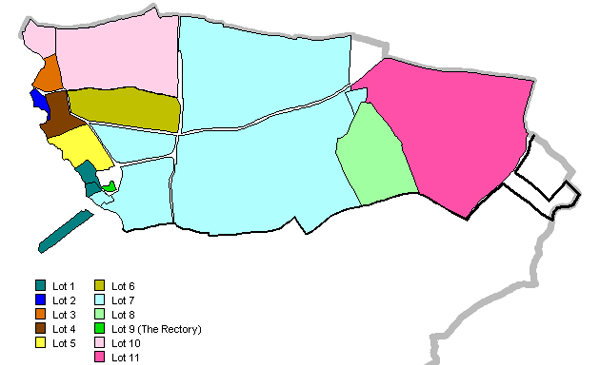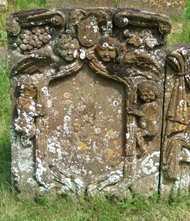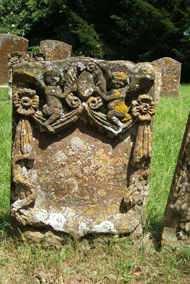Following the abortive Jacobite Rising of 1715 when supporters of the exiled Stuart kings staged a rebellion against their successors, Catholics were required to register their estates with a view to their confiscation. When in June 1717 William (1684-1766), third son of Ralph Sheldon of Weston (1652-1720), gave an account of his lands in the county to the magistrates at the Quarter Sessions in Warwick he described the greatest part of Barcheston manor house as being ‘demolished’; attached to it were a little plot of garden ground and a barn, inhabited rent-free by a poor man, James Chadwick.(1) Its lands, described variously as pasture, meadow or mowing ground, were sublet, shared between four lessees – Richard Brent, presumably the son of the previous lessee William, Richard Brayn and John Watkins. The fourth, un-named, appears to have held the lands belonging directly to the manor, probably the medieval demesne lands; in particular he was discouraged from ploughing Nattocks Mead. Two, Brent and Brayn, were tenants at will, the other two held their land for fixed terms of ten and twenty-one years respectively. The mill with its house and orchard had been treated differently, and were already let on a lease to tenants he did not name, for 99 years but with a rent charge of £100 payable to Ralph Sheldon for life and the obligation to pay a modus of £4 to the rector of Barcheston in lieu of the little tithes which he should have received from the parish of Studley – echoes of an old link.
By mid-century when several of these contracts had expired, there was a chance to review letting terms. In 1745 a four year lease between William Sheldon (d.1780) and Samuel Young of Hook Norton, yeoman, reunited five meadows previously separately rented – Little Hill and Town Meadow (previously rented to Richard Davies and then to Thomas Braine) with Nattocks, Rough Ground and Nattocks Meadow, once leased to Daniel Parry. If Young wished he could, on payment of a higher rental, ‘plow, dig or break up and turn into tillage’ part of what was still meadow. The crops he was apparently expected to sow included rape, woad, weld, hemp or flax.(2) He too was to pay tithes except the modus and his cattle were to eat the chaff, hay, straw and fodder, their dung ‘to be spread in a husbandly manner where most wanted.’ William Sheldon was to retain the timber and fishing rights and was to hand the land over with the gates, stiles, rails, hedges and fences in good repair.
Daniel Parry and his wife Hannah, former lessees of part of this area, had other property in the parish and were also the lessees of the mill, its garden, orchard, hams and osier beds; their family may have taken over as early as 1681.(3) Their lease was renewed for only eight years from April 1762. Again, the Sheldons retained the fishing and the timber except the oak needed for building repairs. The Parrys had the right to an elm tree for repair only of flood damage, but had to give notice before its cutting and immediately plant a new tree.(4)
After the death of William in 1780 as a bankrupt his descendants began to give consideration to the possibility of sale. The manor house and, at least as important, its lands, continued to be let. In May 1788 a lease to John Smith, gentleman, of Shipston on Stour of the mansion house, its outhouses, buildings yards, gardens and ‘several grounds or parcels of inclosed grounds’ was renewed for a further twenty-one years at an annual rent of £604 17s 4d, with the proviso that he would quit quietly if the premises were sold. The lease stipulated that any of the land he broke up or converted to tillage was again to be planted with flax, hemp or woad; if he did so that land would attract a higher rent. In his last term he was to leave seventeen acres planted with Spring Corn ‘commonly called the Lent crops’ with good and sufficient quantity of clover and rye grass. In addition to more usual conditions Smith was expected to keep a hound, greyhound, pointer spaniel dog or bitch for the whole twenty-one years for Ralph Sheldon and was also expected to fetch four tons of coals from Shipston to Weston.(5) The parish registers suggest that the property had been relet, to Samuel Wheatley, by 1799.
Three clauses in the document were deleted, all of which throw some light on what previous circumstances. Part of the manor lands seem to have been occupied by one Diston and John Diston, Walter Webb and Robert Haynes.(6) A second deletion reveals that Smith and the Distons were free to plough Haynes’ and the Great Ground part of Pool Ground and to continue it in tillage for three years before returning it to fallow and then to grass. Sheldon agreed to build a cow shed or ‘cow hovell’ at or near the barn called Haynes Barn and another at Diston’s Yard (the present recycling facility) where he would also erect a pump. Annotations tell us that the tillage land – presumably that rented by Smith - was about 70 acres; that if Mr Edward Wells departs from the lands he leased John Smith was to take them over at the same rent and that Smith himself was obliged to have manured the ground three years before his lease expired.
Ten years later, in May 1798, Richard Wincot, who also farmed in Brailes, took over land identifiable as the present Barcheston Grounds Farm. He leased the messuage, stable, barn, yard and rickyard and five closes and inclosed arable called Long Ground, 3-acre Close, Hovel Ground, Long Pool Close and Barn Ground, totalling forty-seven acres previously occupied by Arthur Dyer, under-tenant to Michael Pettipher, who then held Barcheston manor farm.(7) Wincot’s was a short term lease, for only ten years at an annual rent of £51 4s 6d. This time it was stipulated that the same crop must not be grown more than three years successively and the land was to lie fallow every fourth year. Flax, woad, rape, weld or hempseed were not to be sown, ‘nor anything to injure the ground’. Wincot too was expected to pay the tithes, haul coals, not misuse the timber and, most expensive, to ‘put in tenantable order’ the buildings, except the thatching and glazing in addition to repair of gates, fences and hedges.
Predating access to Barcheston Grounds from the turnpike, the modern B4035, the rights of way as used by the previous tenant – his name unrecorded – through certain closes called Nattocks Meadow and Little Hill were safeguarded in view of another intended lease to Thomas Hodgkin of Shipston.(8) The approach is preserved now as the track eastwards from Willington towards Famington Farm and in the green way beyond.
Selling the manor seems to have proved more difficult than anticipated. A notice to sell at public auction in lots ‘at a time and place to be hereafter named unless previously disposed of by Private Contract…’ first appeared in Jackson’s Oxford Journal on 8 April 1797 and was displayed for two months. The principal estate (467 acres, worth £930 per year) would be vacant at Lady Day 1798, the three other farms leased for twelve years to come. The mill, together with the perpetual advowson, the only part to sell, were also offered.
A valuation was carried out in June 1797.(9) Some new leases were drawn up early in 1798 and the estate again put on the market on 6 April 1799.(10) The auction was set for 8 May at Garraways Coffee House in Change Alley, London in six lots, presumably those shown on the Map below. One third of the leases would expire in ten years’ time, the remainder were on an annual basis. The manor house, described as ‘lately rebuilt’ in the earlier advertisement, was this time said to be ‘a SPACIOUS FARM HOUSE, a part lately rebuilt and so constructed that at a small Expence may be made a suitable Residence for a genteel Family.’ The estate had a rental value of £1000, ‘the soil naturally fertile’ lying very compact and ‘capable of very great Improvement’. Nevertheless, the Sheldons found no buyer.

This division of the Sheldons’ estate in Barcheston was set out in 1797. The plan reflects the leasing arrangements followed through the century and must represent the proposed auction lots of 1799 and 1806. Based on information in WaCRO CR 580/35(1, 2) mapped onto Ordnance Survey 25 inch first edition 1885. © Click Here for a more detailed map
With thanks to Mike Athanson of the Bodleian Library, Oxford.
For much of the century it is possible to name the occupiers liable for tithes and for the land tax of Willington’s farms, few records illustrate their daily life.(11) A long series of deeds survives for only one property, describing a ‘messuage, cottage or tenement, barn, orchard and garden now [1700] in the possession of John Ashfield’.(12) It passed through at least three owners before being purchased by the rector and churchwardens in 1827 for the use of the parish. It is probably therefore the parish cottage shown on the tithe award of 1839 as 29a, opposite Rushway farm.
The Snow family whose members are found first at Barton on the Heath and Ilmington, from where they then moved to Tidmington can also be traced.(13) A datestone TS 1728 above the door probably marks the rebuilding and enlargement of the present Bridge Farm by Thomas Snow whose nephew Gastrel owned it in 1797. His property was mapped in that year, probably in connection with his will, showing that he had once owned the buildings now the converted barns west of College Farm, all the orchard which occupied the centre of the settlement and fields totalling 39 acres closer to Famington.(14) By 1839 his son Isaac Giles Smith Snow, then aged 68, owned only Bridge Farm land, some 16 acres.
Still more can be deduced from analysis of the tithe award.(15) Another member of the Snow family, Thomas, born 1759, became rector of Tidmington.(16) He seems to have been wealthy enough to purchase the land attached to Manor Farm (See map in the nineteenth century section), possibly around 1767 when he revived the claim to be lord of the manor of Willington, on unknown grounds. The title descended through his family.(17)
Many of the families named in the Hearth Tax records however disappeared, for the example the Amsdens and the Jones, replaced by Smith, Taylor and later Holtom. But although their properties can be traced, their fortunes and even their occupations are unknown.
References:
1. Warwickshire Record Office, Quarter Sessions QS 9/5/vii m.9, June 1717. Background material at http://www.nationalarchives.gov.uk/records/research-guides/catholics.htm and post 1715 Act (I Geo., I.St.2.c.50) appointing commissioners to inquire into the estates of popish recusants with a view to confiscating two-thirds of each estate. The scope of "An Act to oblige papists to register their names and real estates" (I. Geo. I. St. 2. c. 55) is sufficiently indicated by its title. The banner crop images from left to right are reproduced courtesy of; Weld - Anne Burgess, Flax - Handwerker and Weld - Lairich Rig.
2. CR 580/23 13 June 1745; the rent was £92 p.a.
3. Hannah died in 1781,and her son, another Daniel, in 1791, Par Reg.
4. WaCRO CR 580/17/7.
5. WaCRO CR 580/24. The parish registers suggest it did not run the complete term; Samuel Wheatley was in possession by 1799 when he baptised a son.
6. Identified in WaCRO CR 580/92.
7. WaCRO CR 580/25; Shakespeare Centre Library and Archives (SCLA) ER 12/10/1.
8. SCLA ER 12/10/6.
9. WaCRO CR 580/35/1-26.
10. Jackson’s Oxford Journal weekly from 30 March – 4 May 1797; the phrase helps date the present house. The only surviving drawing of the house shows an eighteenth century structure with the dilapidated remains of an earlier structure to the north, subsequently also rebuilt. The new leases are SCLA ER 12/10/3, 4, 5, 6, 7.
11. WaCRO CR 580/302; QS 77/26/1-55 (1775-1832)
12. WaCRO DR 354/15-28.
13. Ancestry, name search of parish registers.
14. Shakespeare Centre Library and Archives, Stratford (SCLA), ER 23/7; tithe award 1839 nos. 83, 74, 73, 109 and 110.
15. WaCRO CR 569/21(2) or TNA IR 30/36/160 (text).
16. Tidmington parish registers, Ancestry; Alumni Oxonienses 1715-1886,,ed.J. Foster, Oxford 1888.
17. Gamekeepers’ Deputations, WaCRO, cited in VCH Warwickshire, vol 5, p.6 n.53.





